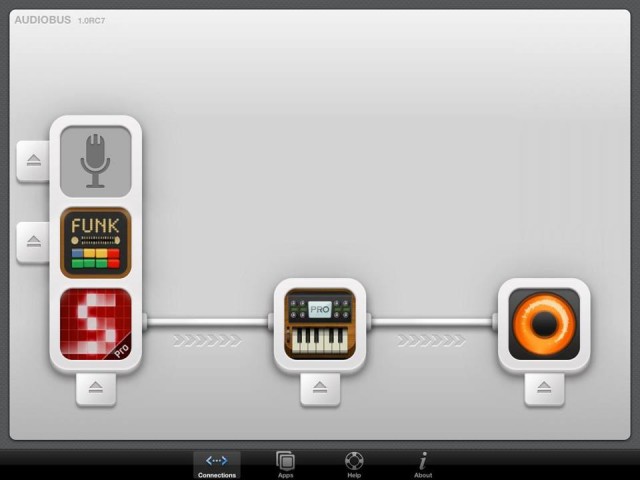For months, you’ve heard about Audiobus, an app that allows iOS apps to work together rather than being isolated tools. Now you can try it – and see if connecting apps on iPhone, iPod touch, and iPad can make you more musically productive. The video above puts it more nicely than a written explanation could, summing up what it means to be able to easily combine apps. It’s nothing new: software for computers and patch cables for hardware have done this before. But that’s the point: connecting musical tools can make them more powerful, and the ease with which they connect makes a huge difference.
Here’s the bit you’ve been waiting for: Audiobus on the iTunes App Store:
Audiobus, A Tasty Pixel
In addition to the “here’s what this thing does in a minute” pitch above, we’re also seeing the first of what I expect will be many hands-on impressions.
I received an early copy of Audiobus yesterday to try it out while playing live MIDI through it. I was pleasantly surprised that it barely adds any latency and reacts really well. The shortcut bar is extremely useful and app-specific icons makes it very easy to interact with backgrounded applications while having another app in the foreground.
In this short demo I’m using my Eigenharp Alpha with a pre-release of PPG WaveGenerator. It’s fed into JamUp for additional effects and amp simulation. Loopy HD sits at the output side to build up the loops. I’m also using FunkBox, MIDI-synced to Loopy, for the drums.
The Eigenharp is connected with iConnectMIDI through a USB hub, into the camera connection kit to send the MIDI with virtually no latency and at a very high bandwidth. I use a Matrix USB/SPDIF interface that’s also plugged into the USB hub and recorded the iPad audio digitally without any post-processing.
This is all extremely promising imho!
Our friend and CDM reader Geert Bevin shared with us over the weekend his own experience using Audiobus so far, complete with video, via our Facebook page.
Also worth checking out as you investigate iOS creation workflows is this creation on virtual MIDI. It’s not Audiobus – this handles the MIDI portion – but combine this with Audiobus, and things get interesting:
Tutorial: Setup to Song in Genome [Discchord]
If you need a DAW to combine your Audiobus glue, Synthtopia notes over the weekend that Multitrack DAW has just added support:
MultiTrack DAW for iOS Updated With Audiobus
The developers also post a nice set of reflections on the development process:
Thirteen Months of Audiobus
For nearly all users – and even for many developers – today is really the beginning of this set of tools on iOS. Some readers were disappointed that there weren’t more apps available, but we know that a) the SDK is extremely easy to work with and support, b) a vast number of developers are signed up for it and have promised compatibility, and c) Audiobus’ creators are rolling out that SDK to developers gradually rather than all at once. So I expect the scene could be radically different by spring.
The place to watch that will be the official site:
http://audiob.us
And, of course, here. But I do hope the impact of Audiobus is beyond only iOS: it seems like there are some user interface ideas and usability notions that could be just as valid for creating new interfaces to tools like JACK.
Looking the opposite direction, all of this has gotten attention beyond just our little music tech-y circles. (I mean, yes, sure, we’re the sexiest and most intelligent boys and girls around, us music technology nerdsters, but it is nice to see the “normals” take note, too.)
Mobile music-making just got a lot more interesting: Meet Audiobus [The Next Web]
More interesting, indeed. Let us know how it works for you in The Real World, folks.
